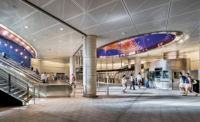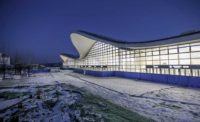Best of the Best 2016
Airport/Transit: Number 7 Subway Line Extension

No. 7 Line Subway Extension
PHOTO COURTESY OF HILL INTERNATIONAL

No. 7 Line Subway Extension
PHOTO COURTESY OF HILL INTERNATIONAL

No. 7 Line Subway Extension
PHOTO COURTESY OF HILL INTERNATIONAL



No. 7 Line Subway Extension
New York City
Region New York
Airport/Transit
Project Team
Owner New York Metropolitan Transportation Authority Capital Construction Co.
Designer of Record the Parsons Brinckerhoff Team
Lead Architect Dattner Architects
Construction Manager Hill International Inc., the Liro Group and Hdr Inc.
General Contractors S3II (a Joint Venture of J. F. Shea Construction Inc.); Schiavone Construction Inc. and Skanska USA Civil NE; CCA Civil – Halmar International LLC, a joint venture of CCA Civil, Inc. and Halmar International, LLC; Skanska/Railworks, a joint venture of Skanska USA Civil NE and Railworks; Yonkers Contracting Co.; Scalamandre/Oliveira, a joint venture of Peter Scalamandre & Sons Inc. and Oliveira Contracting); and John P. Picone Inc.
The $2.4-billion, 1.5-mile No. 7 Subway Line Extension Project in Manhattan is the nation’s first of its kind to feature no federal funding as well as the innovative use of ground freezing in a 300-ft stretch for tunnel boring. As the first extension to the city’s subway system in 25 years, the project incorporated state-of-the-art design amenities and technologies in its three-story, 125-ft-deep 34th Street-Hudson Yards station, such as 70-in. plasma panels, inclined elevators, column-free and granite-tiled space, and a mosaic ceiling. The track along the extension is insulated with rubber, providing riders with a smoother and quieter ride. The so-called Rhomberg technology became a model for track experts from transit agencies all over the U.S.
In 2009, the joint venture of J.F. Shea Construction, Skanska Civil and Schiavone Construction decided to freeze a mixed-soil section of earth and run the 22.5-ft-dia pair of tunnel-boring machines through it nonstop. “Nobody had ever run a TBM through frozen ground before,” says Gary Almeraris, project executive for Skanska. Crews built three freeze plants and drilled aluminum-and-steel pipes 140 ft deep—5 ft below the future tunnel floor. Pipes within the pipes carried into the ground calcium chloride brine, frozen to -25°C. “We had a block of frozen ground completely through the alignment, with thick walls on either side and a crown above,” says Almeraris.
One at a time, each TBM mined through the section, including the now-empty pipes. Then, precast tunnel-liner segments were grouted into place. “Even placing segments in a rock tunnel, we had never done that before,” says Sean Kildare, project executive with the Metropolitan Transportation Authority Capital Construction Co.
The extension also passes beneath the Port Authority of New York & New Jersey’s bus terminal; to make room, crews had to drill and blast 6,000 cu yd of rock in the terminal’s lower level. “We put a deck over the area, and the port authority continued its operations, 24 hours a day,” says Kildare. People boarded buses just feet away from the drilling and blasting.
During the eight-year project that involved six major contracts, another, $266-million scope was included, but no additional time was included in the schedule. The program used a critical path method and an integrated master project schedule for each construction contract; both were monitored on a monthly and weekly basis. Each construction schedule had more than 1,000 activities; the largest had more than 7,000 activities. Stringent management resulted in a net change-order level below 3%.
The $2.4-billion extension was funded by New York City funds from municipal tax increment financing (TIF) bond sales, which are expected to be repaid with property tax revenues from future developments in areas served by the extension. The project is a key component of the economic development of Manhattan’s far West Side, serving as a link to 18 existing subway lines, the Jacob Javits Convention Center, the High Line, the newly opened Hudson River Park and ferries.
Trains are monitored and controlled by a communications-based train control system, one of the first of its kind in the U.S. Before such technology, train sets had to be longer, says John Drygulski, vice president of Hill International.







